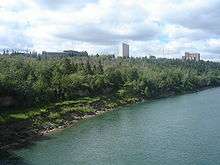Urban parks in Canada
Urban parks in Canada are areas for public recreation and enjoyment or natural preservation in cities in Canada. They are often owned and operated by municipal governments and so are usually called 'municipal parks', and sometimes 'regional parks' depending on the park's features and local government structure.


The amount of total park space per person and as percentage of total land in Canadian cities varies substantially. Many Canadian cities are located near large provincial and national parks, and other rural areas such as "cottage country" which also provide recreation areas for urban dwellers but may reduce the incentives for cities to preserve parkland within municipal boundaries. Some Canadian urban parks may be neatly tended public gardens reminiscent of the old world, but many of the largest are completely undeveloped open spaces.
List by city
Vancouver has approximately 1,300 hectares (3,200 acres) of total parks, much less total area than other Canadian cities, but this represents 11% of the city's total area, the highest percentage in a Canadian major urban centre. Stanley Park in particular is 400 hectares (990 acres), and features an 8.8-kilometre (5.5 mi) seawall.
Winnipeg has approximately 4,047 hectares (10,000 acres) of total parkland,[1] which amounts to 6.1 hectares (15 acres) of parkland for every 1000 residents within the city proper, or 5.5 hectares (14 acres) per 1000 residents living within the Winnipeg Capital Region. The city's primary park, Assiniboine Park, covers upwards of 450 hectares (1,100 acres) of land including the 280 hectares (690 acres) Assiniboine Forest, 160 hectares (400 acres) manicured English gardens, and 36 hectares (89 acres) Assiniboine Park Zoo.
Calgary's urban parks include are Nose Hill Park at 1,127 hectares (2,780 acres) and Fish Creek Provincial Park at 1,348 hectares (3,330 acres).[2]
Edmonton's North Saskatchewan River valley parks system is a 18,000-hectare (44,000-acre) "ribbon of green" running through the city.[3] It is the largest urban park in Canada. It has 20 Major parks and 160 kilometres (99 mi) of trails.[4] The city also maintains 4,600 hectares (11,000 acres) of grass fields for sports and leisure.[5][4]
Ottawa has around 8 hectares (20 acres) of parkland for every 1000 residents. This compares to only 3.24 hectares (8.0 acres) per 1000 people in Toronto and 1.2 hectares (3.0 acres) per 1000 people in Montreal. For an international comparison London, England, the city with the largest number of total parks in the world, has 2.7 hectares (6.7 acres) of parks per 1000 people and a total of about 4,000 hectares (9,900 acres).
The City of Whitehorse, Yukon encompasses some 41,900 hectares. In the 2010 Official Community Plan,[6] the city created five new regional parks to reflect environmental and recreational values: Chadburn Lake Park, McIntyre Creek Park, McLean Lake Park, Paddy's Pond - Ice Lake Park, and Wolf Creek Park. Together, this regional park system encompasses 30% of the city's total area (12,655 hectares) with Chadburn Lake Park being the largest regional park at 7,550 hectares.[7] A further 33% was set aside as the Green Space Network Plan to protect ecosystems, encourage connectivity, provide City-wide outdoor recreation opportunities, and to promote compact development.
See also
References
- ↑ Economic Development Winnipeg - Parks & Recreation
- ↑ Calgary Economic Development - Major Parks
- ↑ "Plan of Action". River Valley. River Valley Alliance. Retrieved 14 May 2016.
- 1 2 "River Valley Parks". The City of Edmonton. The City of Edmonton. Retrieved 14 May 2016.
- ↑ City of Edmonton
- ↑ http://www.whitehorse.ca/index.aspx?page=249
- ↑ http://www.whitehorse.ca/index.aspx?page=638